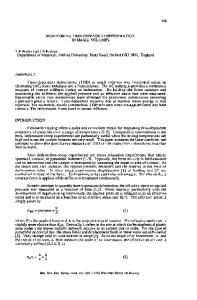Deformation of Small Volumes of Material Studied Using Strained-Layer Superlattice Structures
- PDF / 284,113 Bytes
- 6 Pages / 612 x 792 pts (letter) Page_size
- 27 Downloads / 351 Views
U6.3.1
Deformation of Small Volumes of Material Studied Using Strained-Layer Superlattice Structures K.M.Y. P’ng,1 A.J. Bushby1 and D.J. Dunstan2 Centre for Materials Research, 1 Department of Materials, Queen Mary, University of London, E1 4NS, UK. 2 Department of Physics, Queen Mary, University of London, E1 4NS, UK.
ABSTRACT Mechanical studies of semiconductor superlattices have shown that the onset of plastic deformation under an inhomogeneous stress is a process that takes place simultaneously across a finite volume of the order of a micron across. The ability to incorporate known internal stresses, and to vary the stress and thickness of individual layers in a semiconductor superlattice, is a very powerful tool, opening up new possibilities for investigations that cannot be achieved by varying external stresses on a specimen that is sensibly homogeneous. In this way, from the initial yield stress of single-crystal strained-layer superlattices under indentation, we demonstrated a new criterion, of which the key feature is that it is to be averaged over a finite volume. Here we show that designing samples with individual layers in bands to form low yield-stress material within the structure can give information about the size and position of the initial yield volume.
INTRODUCTION Jayaweera et al [1] reported that the yield stress of coherently strained InxGa(1−x)As superlattices can be controlled simply by the magnitude of the strain modulation of the superlattices. Yield stress under indentation decreases linearly with strain modulation. At the highest strains the yield pressure is halved. The way in which the yield pressure varies with the superlattice parameters (layer thicknesses and strains) led us to conclude that the onset of plastic yield occurs simultaneously throughout a finite volume of the order a micron across [2, 3]. The in-built coherency stress adds to the external stress to induce dislocation movement at a lower external stress than otherwise necessary. Understanding the finite volume throughout which deformation begins is necessary to understand the mechanics of small-scale deformation. A finite volume for small-scale deformation can explain why nanostructuring of materials can control or modify the strength, and a proper understanding should enable the design of optimised materials. The purpose of this paper is to show how suitable design of superlattice samples may be able to map out this finite volume and directly measure its size and depth. We report a preliminary demonstration of the feasibility of this, using two samples.
Downloaded from https://www.cambridge.org/core. The Librarian-Seeley Historical Library, on 06 Jan 2020 at 02:26:04, subject to the Cambridge Core terms of use, available at https://www.cambridge.org/core/terms. https://doi.org/10.1557/PROC-778-U6.3
U6.3.2
FLEXIBILITY OF InGaAs SUPERLATTICE DESIGN AND GROWTH The motivation of this work is to determine the volume at the initiation of plastic yield. In most materials and structures, this problem could be addressed o
Data Loading...










